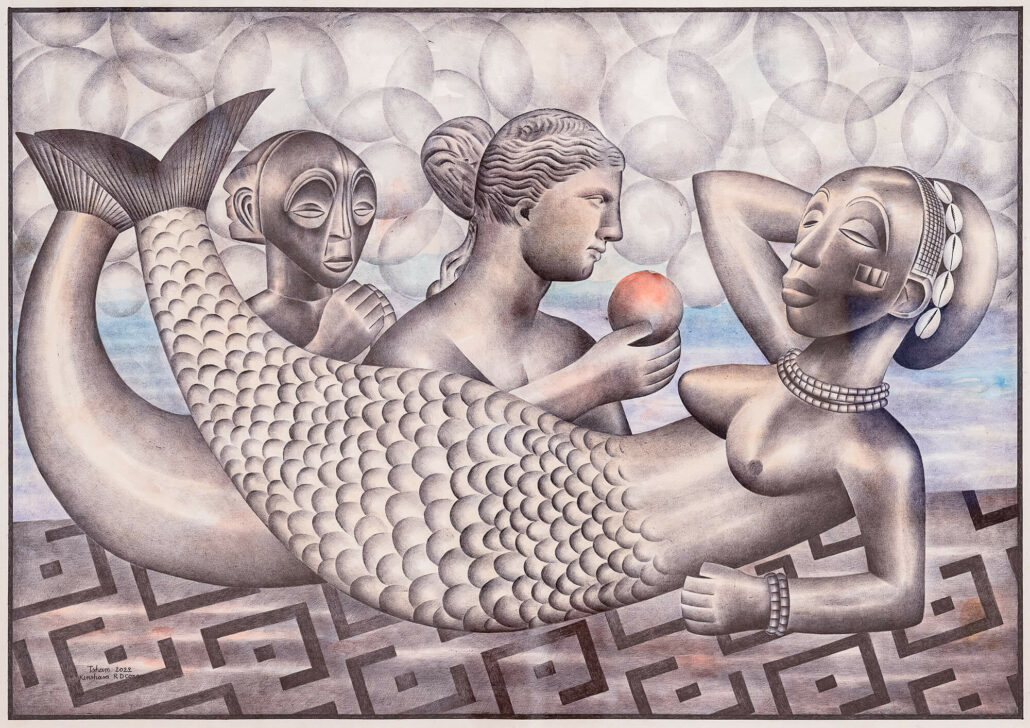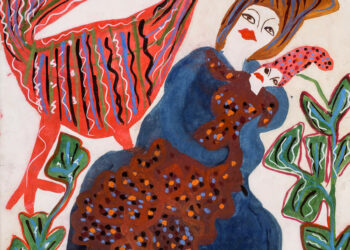Glitch is an English term of Yiddish origin meaning “slippery area”. Interpreted as an error in a structured system, it is an expression widespread in the digital world that evokes a computer’s brief failure.

Tsham, Sirène Mami Wata, 2022. Courtesy of the artist and Christophe Person.
The digital anomaly offers the computer an opportunity to act on its own. This unexpected phenomenon results in a random visual where images with surprising patterns and garish colours scroll across the screen, sometimes accompanied by a shrill sound.
These errors in the matrix are still unpredictable and incomprehensible. They can be seen as a loss of control over an autonomous system, the premises of the dangerousness of artificial intelligence. For example, in video games, this bug has even become one of the techniques to deceive the machines and win against other players.
In homage to these bugs, visual artists today refer to glitches to briefly bypass what is expected in the dominant art system. Elliptically, the proposals of African artists emerging from their imaginations have glitch-affected the ecosystem of Western art. The unexpected, their creations’ independence and originality offer complex narratives and are sometimes confusing for the art market.
This exhibition is carte blanche given to artists Jourdan Tchoffo, John Baptist Sekubulwa and Tsham to take part in the glitch and seize this opportunity to occupy space in a disruptive way in the global game of the art world. Surprising by their techniques and visions, they divert the use of the ballpoint pen and palettes in pastel and joyful colours to disturb the stereotypical ideas of violent and sad African realities where the dream, the rupture in everyday life, the glitch seemed improbable.
Born on September 2, 1963, in Lubunza, Tsham grew up in Mwene-Ditu, Kasaï-Oriental, and today lives in Kinshasa in the Democratic Republic of Congo. Tsham sketches his compositions in black pencil and then patiently hatches the volumes with a ballpoint pen. The edges of each painting evoke the regular textile borders of the loincloths, and the backgrounds offer an abundance of figures in harmony with the central composition.
Jourdan Tchoffo’s work combines academic, family and political influences. Born in 1994 in Bafoussam in Cameroon, Tchoffo has been immersed in Japanese comic books and manga since a young age. In his drawings from primary school, he concentrates on characters, people, still lifes, landscapes and household appliances. He studies visual arts and comics at the University of Foumban. Imbued with the photographic practice of Seydou Keïta, Malick Sidibé, Jean Depara, Philippe Koudjina and James Barnor, it displays a worked aesthetic where the interiors are meticulously cared for and prepared to receive the models of the photographs.
Tchoffo plunges the viewer straight into his ideal, joyful and smooth universe. Finally, smooth or smoothed? His works seem ultimately ordered a happy assemblage. He paints the background, then the models and still lifes. This assembly appears way too perfect.
John Baptist Sekubulwa is a Ugandan artist born in 1990 in Kampala. He graduated from the Margaret Trowell School of Industrial and Fine Arts, Makerere University. From a creative and curious family, he was encouraged to be interested in art from a young age. He developed a passion for newspaper comic strips, which he stole from his father. He draws in his notebook, which he always carries with him, and these sketches become an actual language of love in his family. Obsessed with introspection and constant questioning, John Baptist Sekubulwa seeks to “unlearn” and construct his identity despite his heritage and person’s many contradictions.
From his studio in Kampala, he presents a new series of characters with childish features and bulging eyes that are reminiscent of the kitsch of emojis and selfies. Both personifications of moral values and humorous caricatures of the great vices of society project us into a sweet and innocent atmosphere. They are also imbued with the questions of a young adult with significant responsibilities, like his country, which is trying to rebuild itself after decades of post-independence political violence.
The exhibition will be on view from the 14th of September until the 14th of October, 2023. For more information, please visit Christophe Person.



